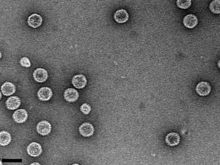Picobirnavirus
| Picobirnavirus | |
|---|---|

| |
Electron micrograph of human picobirnavirus particles
| |
| Virus classification | |
| (unranked): | Virus |
| Realm: | Riboviria |
| Kingdom: | Orthornavirae |
| Phylum: | Pisuviricota |
| Class: | Duplopiviricetes |
| Order: | Durnavirales |
| Family: | Picobirnaviridae |
| Genus: | Picobirnavirus |
Picobirnavirus is a genus of
Etymology
Picobirnavirus is a small (pico,
Structure
Viruses in the genus are non-enveloped, with icosahedral geometries, and T=3 symmetry. The diameter is around 35–40 nm.[5][4]
Genome

The
Picobirnaviruses are divided into two genogroups on the basis of the sequence of segment 2. The
Life cycle
Picobirnaviruses target intestine tissue. Entry into the host cell is achieved by penetration into the host cell. Once in the host cell, viral replication is cytoplasmic. Replication follows the double-stranded RNA virus replication model. Double-stranded RNA virus transcription is the method of transcription. The viruses are released from the cell by budding. Mammals serve as the natural host. Transmission routes are fecal-oral.[5][4]
Taxonomy
Picobirnaviruses were initially thought to belong to the family Birnaviridae, but later were confirmed to differ with respect to host, virion size, capsid, RNA-dependent RNA polymerase, genome size, and organization.[9] The family Picobirnaviridae is now classified distinctly and composed of one genus Picobirnavirus, which has three species:[10]
- Beihai picobirnavirus
- Equine picobirnavirus
- Human picobirnavirus
References
- PMID 30484763.
- PMID 29346073.
- PMID 29644096.
- ^ a b c d e "Viral Zone". ExPASy. Retrieved 15 June 2015.
- ^ a b c "ICTV Report: Picobirnaviridae".
- PMC 6924892.
- PMID 3053986.
- PMID 22932227.
- PMID 25136620.
- ^ "International Committee on Taxonomy of Viruses (ICTV)". talk.ictvonline.org. Retrieved 8 October 2020.
External links
- Malik, YS (2014). "Epidemiology, phylogeny, and evolution of emerging enteric Picobirnaviruses of animal origin and their relationship to human strains". Biomed Res Int. 2014: 1–13. PMID 25136620.
- Chandra, R (1997). "Picobirnavirus, a novel group of undescribed viruses of mammals and birds: A minireview". Acta Virologica. 41 (1): 59–62. PMID 9199719.
- Rosen, B; Fang, ZY; Glass, RI; Monroe, SS (2000). "Cloning of Human Picobirnavirus Genomic Segments and Development of an RT-PCR Detection Assay". Virology. 277 (2): 316–29. PMID 11080479.
- Taxonomic proposal for picobirnaviridae at the ICTV
- Viralzone: Picobirnavirus
- ICTV Report: Picobirnaviridae
